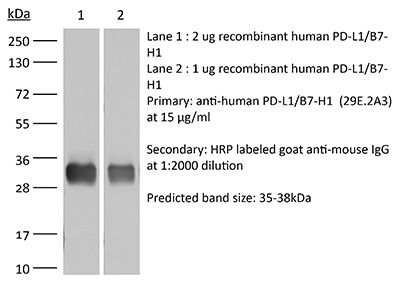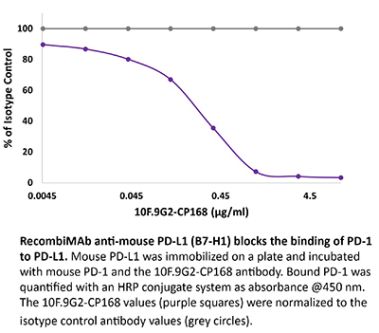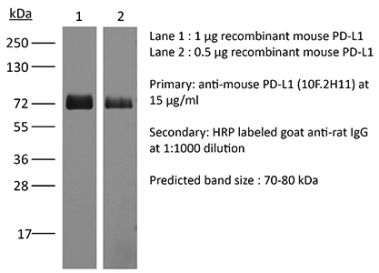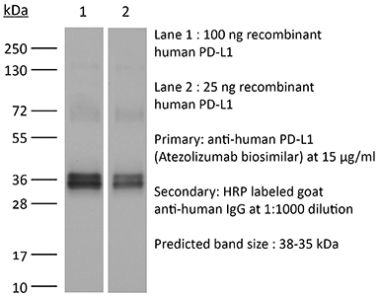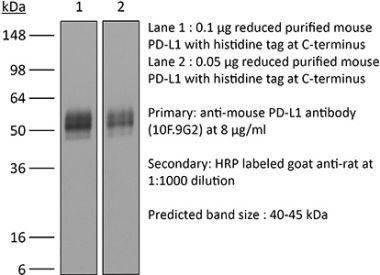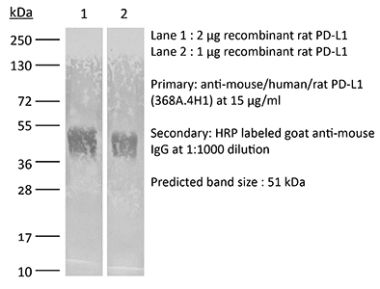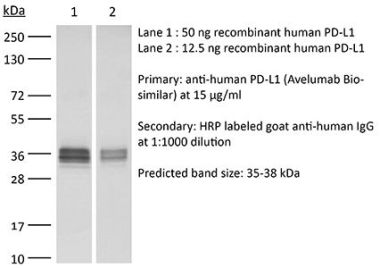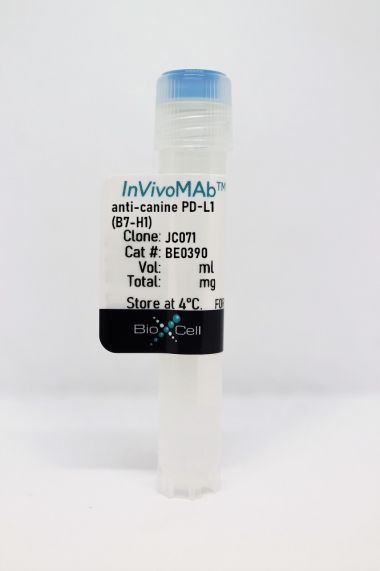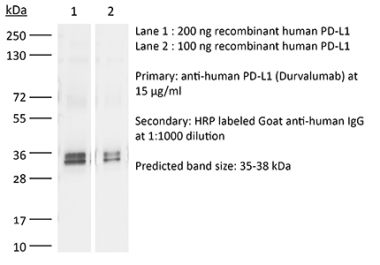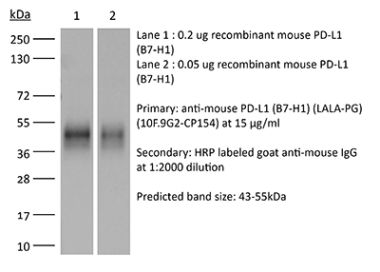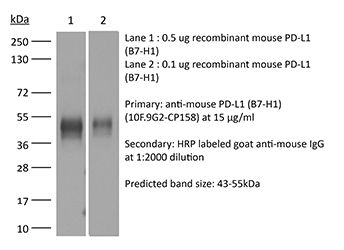InVivoMAb anti-human PD-L1 (B7-H1)
Product Details
The 29E.2A3 monoclonal antibody reacts with human PD-L1 (programmed death ligand 1) also known as B7-H1 or CD274. PD-L1 is a 40 kDa type I transmembrane protein that belongs to the B7 family of the Ig superfamily. PD-L1 is expressed on T lymphocytes, B lymphocytes, NK cells, dendritic cells, as well as IFNγ stimulated monocytes, epithelial cells and endothelial cells. PD-L1 binds to its receptor, PD-1, found on CD4 and CD8 thymocytes as well as activated T and B lymphocytes and myeloid cells. Engagement of PD-L1 with PD-1 leads to inhibition of TCR-mediated T cell proliferation and cytokine production. PD-L1 is thought to play an important role in tumor immune evasion. Induced PD-L1 expression is common in many tumors and results in increased resistance of tumor cells to CD8 T cell mediated lysis. The 29E.2A3 antibody has been shown to block the binding of PD-1-Ig to PD-L1.Specifications
| Isotype | Mouse IgG2b, κ |
|---|---|
| Recommended Isotype Control(s) | InVivoMAb mouse IgG2b isotype control, unknown specificity |
| Recommended Dilution Buffer | InVivoPure pH 7.0 Dilution Buffer |
| Conjugation | This product is unconjugated. Conjugation is available via our Antibody Conjugation Services. |
| Immunogen | Full length human PD-L1 |
| Reported Applications |
in vitro PD-L1 blockade Functional assays Immunohistochemistry (frozen) Flow cytometry |
| Formulation |
PBS, pH 7.0 Contains no stabilizers or preservatives |
| Endotoxin |
<2EU/mg (<0.002EU/μg) Determined by LAL gel clotting assay |
| Purity |
>95% Determined by SDS-PAGE |
| Sterility | 0.2 µm filtration |
| Production | Purified from cell culture supernatant in an animal-free facility |
| Purification | Protein G |
| RRID | AB_2687808 |
| Molecular Weight | 150 kDa |
| Storage | The antibody solution should be stored at the stock concentration at 4°C. Do not freeze. |
Recommended Products
Functional Assays
Sivakumar, R., et al. (2019). "Organotypic tumor slice cultures provide a versatile platform for immuno-oncology and drug discovery" Oncoimmunology 8(12): e1670019. PubMed
Organotypic tumor slices represent a physiologically-relevant culture system for studying the tumor microenvironment. Systematic characterization of the tumor slice culture system will enable its effective application for translational research. Here, using flow cytometry-based immunophenotyping, we performed a comprehensive characterization of the immune cell composition in organotypic tumor slices prepared from four syngeneic mouse tumor models and a human liver tumor. We found that the immune cell compositions of organotypic tumor slices prepared on the same day as the tumor cores were harvested are similar. Differences were primarily observed in the lymphocyte population of a clinical hepatocellular carcinoma case. Viable populations of immune cells persisted in the tumor slices for 7 days. Despite some changes in the immune cell populations, we showed the utility of mouse tumor slices for assessing responses to immune-modulatory agents. Further, we demonstrated the ability to use patient-derived xenograft tumor slices for assessing responses to targeted and cytotoxic drugs. Overall, tumor slices provide a broadly useful platform for studying the tumor microenvironment and evaluating the preclinical efficacy of cancer therapeutics.
in vitro PD-L1 blockade
Broos, K., et al. (2019). "Single Domain Antibody-Mediated Blockade of Programmed Death-Ligand 1 on Dendritic Cells Enhances CD8 T-cell Activation and Cytokine Production" Vaccines (Basel) 7(3). PubMed
Dendritic cell [DC] vaccines can induce durable clinical responses, at least in a fraction of previously treated, late stage cancer patients. Several preclinical studies suggest that shielding programmed death-ligand 1 [PD-L1] on the DC surface may be an attractive strategy to extend such clinical benefits to a larger patient population. In this study, we evaluated the use of single domain antibody [sdAb] K2, a high affinity, antagonistic, PD-L1 specific sdAb, for its ability to enhance DC mediated T-cell activation and benchmarked it against the use of the monoclonal antibodies [mAbs], MIH1, 29E.2A3 and avelumab. Similar to mAbs, sdAb K2 enhanced antigen-specific T-cell receptor signaling in PD-1 positive (PD-1(pos)) reporter cells activated by DCs. We further showed that the activation and function of antigen-specific CD8 positive (CD8(pos)) T cells, activated by DCs, was enhanced by inclusion of sdAb K2, but not mAbs. The failure of mAbs to enhance T-cell activation might be explained by their low efficacy to bind PD-L1 on DCs when compared to binding of PD-L1 on non-immune cells, whereas sdAb K2 shows high binding to PD-L1 on immune as well as non-immune cells. These data provide a rationale for the inclusion of sdAb K2 in DC-based immunotherapy strategies.
in vitro PD-L1 blockade
Porichis, F., et al. (2014). "Differential impact of PD-1 and/or interleukin-10 blockade on HIV-1-specific CD4 T cell and antigen-presenting cell functions" J Virol 88(5): 2508-2518. PubMed
Antigen persistence in chronic infections and cancer upregulates inhibitory networks, such as the PD-1 and interleukin-10 (IL-10) pathways, that impair immunity and lead to disease progression. These pathways are attractive targets for immunotherapy, as demonstrated by recent clinical trials of PD-1/PD-L1 blockade in cancer patients. However, in HIV-1 infection not all subjects respond to inhibition of either pathway and the mechanistic interactions between these two networks remain to be better defined. Here we demonstrate that in vitro blockade of PD-L1 and/or IL-10Ralpha results in markedly different profiles of HIV-1-specific CD4 T cell restoration. Whereas PD-L1 blockade leads to balanced increase in gamma interferon (IFN-gamma), IL-2, and IL-13 secretion, IL-10Ralpha blockade preferentially restores IFN-gamma production. In viremic subjects, combined PD-L1/IL-10Ralpha blockade results in a striking 10-fold increase in IFN-gamma secretion by HIV-1-specific CD4 T cells that is not observed in subjects with spontaneous (elite controllers) or therapy-induced control of viral replication. In contrast to the dramatic increase in IFN-gamma production, concurrent blockade has a marginal additive effect on IL-2 production, IL-13 secretion, and HIV-1-specific CD4 T cell proliferation. IFN-gamma produced by Thelper cells upregulates PD-L1, HLA I/II, and IL-12 expression by monocytes. The effect of combined blockade on IFN-gamma was dependent on reciprocal reinforcement through IL-12. These studies provide crucial information on the different immunoregulatory qualities of PD-1 and IL-10 in progressive disease and link exhausted virus-specific CD4 T cells and monocytes in the regulation of IFN-gamma and IL-12 secretion. IMPORTANCE: Infection with HIV results in most people in uncontrolled viral replication and progressive weakening of the body defenses. In the absence of antiviral therapy, this process results in clinical disease, or AIDS. An important reason why HIV continues to multiply is that a population of white blood cells called CD4 T cells that targets the virus fails to work properly. At least part of this impairment is under the control of inhibitory mechanisms that can be blocked to improve the function of these CD4 T cells. In this report, we show that blocking one or two of the molecules involved, called PD-1 and IL-10, has different effects on the individual functions of these cells and that one is strongly improved. We investigate how these effects are caused by interactions between CD4 T cells and antigen-presenting cells. These observations can have implications for new therapeutic approaches in HIV infection.
in vitro PD-L1 blockade
Hegde, S., et al. (2011). "Human NKT cells direct the differentiation of myeloid APCs that regulate T cell responses via expression of programmed cell death ligands" J Autoimmun 37(1): 28-38. PubMed
NKT cells are innate lymphocytes that can recognize self or foreign lipids presented by CD1d molecules. NKT cells have been shown to inhibit the development of autoimmunity in murine model systems, however, the pathways by which they foster immune tolerance remain poorly understood. Here we show that autoreactive human NKT cells stimulate monocytes to differentiate into myeloid APCs that have a regulatory phenotype characterized by poor conjugate formation with T cells. The NKT cell instructed myeloid APCs show elevated expression of the inhibitory ligand PD-L2, and blocking PD-L1 and PD-L2 during interactions of the APCs with T cells results in improved cluster formation and significantly increased T cell proliferative responses. The elevated expression of PD-L molecules on NKT-instructed APCs appears to result from exposure to extracellular ATP that is produced during NKT-monocyte interactions, and blocking purinergic signaling during monocyte differentiation results in APCs that form clusters with T cells and stimulate their proliferation. Finally, we show that human monocytes and NKT cells that are injected into immunodeficient mice co-localize together in spleen and liver, and after 3 days in vivo in the presence of NKT cells a fraction of the myeloid cells have upregulated markers associated with differentiation into professional APCs. These results suggest that autoreactive human NKT cells may promote tolerance by inducing the differentiation of regulatory myeloid APCs that limit T cell proliferation through expression of PD-L molecules.
in vitro PD-L1 blockade
Nakamoto, N., et al. (2009). "Synergistic reversal of intrahepatic HCV-specific CD8 T cell exhaustion by combined PD-1/CTLA-4 blockade" PLoS Pathog 5(2): e1000313. PubMed
Viral persistence is associated with hierarchical antiviral CD8 T cell exhaustion with increased programmed death-1 (PD-1) expression. In HCV persistence, HCV-specific CD8 T cells from the liver (the site of viral replication) display increased PD-1 expression and a profound functional impairment that is not reversed by PD-1 blockade alone. Here, we report that the inhibitory receptor cytotoxic T lymphocyte-associated antigen-4 (CTLA-4) is preferentially upregulated in PD-1(+) T cells from the liver but not blood of chronically HCV-infected patients. PD-1/CTLA-4 co-expression in intrahepatic T cells was associated with a profound HCV-specific effector dysfunction that was synergistically reversed by combined PD-1/CTLA-4 blockade in vitro, but not by blocking PD-1 or CTLA-4 alone. A similar effect was observed in circulating HCV-specific CD8 T cells with increased PD-1/CTLA-4 co-expression during acute hepatitis C. The functional response to combined blockade was directly associated with CTLA-4 expression, lost with CD28-depletion and CD4-independent (including CD4(+)FoxP3(+) Tregs). We conclude that PD-1 and CTLA-4 pathways both contribute to virus-specific T cell exhaustion at the site of viral replication by a redundant mechanism that requires combined PD-1/CTLA-4 blockade to reverse. These findings provide new insights into the mechanisms of virus-specific T cell dysfunction, and suggest that the synergistic effect by combined inhibitory receptor blockade might have a therapeutic application against chronic viral infection in vivo, provided that it does not induce autoimmunity.
in vitro PD-L1 blockade
Cai, G., et al. (2004). "PD-1 ligands, negative regulators for activation of naive, memory, and recently activated human CD4+ T cells" Cell Immunol 230(2): 89-98. PubMed
We examined the role of the PD-1 pathway on the activation of naive, memory, and recently activated human CD4+ T cells to test whether they responded differently. PD-1 ligand blockade modestly enhanced the percentage of responding T cells and production of IFN-gamma in a primary response to myelin basic protein (MBP) in normal donors. PD-1 ligand blockade strongly enhanced proliferation and cytokine production by memory or recently activated T cells (tetanus toxoid and MBP). Blockade of PD-L1 alone had more effect than PD-L2, consistent with its higher expression on ex vivo dendritic cells; furthermore, anti-PD-L1 plus anti-PD-L2 resulted in the greatest enhancement. Moreover, PD-L1-Ig inhibited anti-CD3 induced activation of naive, memory, and recently activated CD4+ T cells. Together, our data demonstrated PD-1 functioned as a negative regulatory pathway on naive T cells during a primary response, and more potently, on memory or recently activated T cells during a secondary response.
Functional Assays, Flow Cytometry, Immunohistochemistry (frozen)
Brown, J. A., et al. (2003). "Blockade of programmed death-1 ligands on dendritic cells enhances T cell activation and cytokine production" J Immunol 170(3): 1257-1266. PubMed
Programmed death-1 ligand (PD-L)1 and PD-L2 are ligands for programmed death-1 (PD-1), a member of the CD28/CTLA4 family expressed on activated lymphoid cells. PD-1 contains an immunoreceptor tyrosine-based inhibitory motif and mice deficient in PD-1 develop autoimmune disorders suggesting a defect in peripheral tolerance. Human PD-L1 and PD-L2 are expressed on immature dendritic cells (iDC) and mature dendritic cells (mDC), IFN-gamma-treated monocytes, and follicular dendritic cells. Using mAbs, we show that blockade of PD-L2 on dendritic cells results in enhanced T cell proliferation and cytokine production, including that of IFN-gamma and IL-10, while blockade of PD-L1 results in similar, more modest, effects. Blockade of both PD-L1 and PD-L2 showed an additive effect. Both whole mAb and Fab enhanced T cell activation, showing that PD-L1 and PD-L2 function to inhibit T cell activation. Enhancement of T cell activation was most pronounced with weak APC, such as iDCs and IL-10-pretreated mDCs, and less pronounced with strong APC such as mDCs. These data are consistent with the hypothesis that iDC have a balance of stimulatory vs inhibitory molecules that favors inhibition, and indicate that PD-L1 and PD-L2 contribute to the poor stimulatory capacity of iDC. PD-L1 expression differs from PD-L2 in that PD-L1 is expressed on activated T cells, placental trophoblasts, myocardial endothelium, and cortical thymic epithelial cells. In contrast, PD-L2 is expressed on placental endothelium and medullary thymic epithelial cells. PD-L1 is also highly expressed on most carcinomas but minimally expressed on adjacent normal tissue suggesting a role in attenuating antitumor immune responses.
- Cancer Research,
- Immunology and Microbiology
Helicobacter pylori CagA promotes immune evasion of gastric cancer by upregulating PD-L1 level in exosomes.
In IScience on 15 December 2023 by Wang, J., Deng, R., et al.
PubMed
Cytotoxin-associated gene A (CagA) of Helicobacter pylori (Hp) may promote immune evasion of Hp-infected gastric cancer (GC), but potential mechanisms are still under explored. In this study, the positive rates of CagA and PD-L1 protein in tumor tissues and the high level of exosomal PD-L1 protein in plasma exosomes were significantly associated with the elevated stages of tumor node metastasis (TNM) in Hp-infected GC. Moreover, the positive rate of CagA was positively correlated with the positive rate of PD-L1 in tumor tissues and the level of PD-L1 protein in plasma exosomes, and high level of exosomal PD-L1 might indicate poor prognosis of Hp-infected GC. Mechanically, CagA increased PD-L1 level in exosomes derived from GC cells by inhibiting p53 and miRNA-34a, suppressing proliferation and anticancer effect of CD8+ T cells. This study provides sights for understanding immune evasion mediated by PD-L1. Targeting CagA and exosomal PD-L1 may improve immunotherapy efficacy of Hp-infected GC. © 2023 The Authors.
- Cancer Research,
- Immunology and Microbiology
Low-dose radiotherapy combined with dual PD-L1 and VEGFA blockade elicits antitumor response in hepatocellular carcinoma mediated by activated intratumoral CD8+ exhausted-like T cells.
In Nature Communications on 24 November 2023 by Li, S., Li, K., et al.
PubMed
Atezolizumab (anti-PD-L1) combined with bevacizumab (anti-VEGFA) is the first-line immunotherapy for advanced hepatocellular carcinoma (HCC), but the number of patients who benefit from this regimen remains limited. Here, we combine dual PD-L1 and VEGFA blockade (DPVB) with low-dose radiotherapy (LDRT), which rapidly inflames tumors, rendering them vulnerable to immunotherapy. The combinatorial therapy exhibits superior antitumor efficacy mediated by CD8+ T cells in various preclinical HCC models. Treatment efficacy relies upon mobilizing exhausted-like CD8+ T cells (CD8+ Tex) with effector function and cytolytic capacity. Mechanistically, LDRT sensitizes tumors to DPVB by recruiting stem-like CD8+ Tpex, the progenitor exhausted CD8+ T cells, from draining lymph nodes (dLNs) into the tumor via the CXCL10/CXCR3 axis. Together, these results further support the rationale for combining LDRT with atezolizumab and bevacizumab, and its clinical translation. © 2023. The Author(s).
- FC/FACS,
- Cancer Research
Phagocytosis-initiated tumor hybrid cells acquire a c-Myc-mediated quasi-polarization state for immunoevasion and distant dissemination.
In Nature Communications on 17 October 2023 by Chou, C. W., Hung, C. N., et al.
PubMed
While macrophage phagocytosis is an immune defense mechanism against invading cellular organisms, cancer cells expressing the CD47 ligand send forward signals to repel this engulfment. Here we report that the reverse signaling using CD47 as a receptor additionally enhances a pro-survival function of prostate cancer cells under phagocytic attack. Although low CD47-expressing cancer cells still allow phagocytosis, the reverse signaling delays the process, leading to incomplete digestion of the entrapped cells and subsequent tumor hybrid cell (THC) formation. Viable THCs acquire c-Myc from parental cancer cells to upregulate both M1- and M2-like macrophage polarization genes. Consequently, THCs imitating dual macrophage features can confound immunosurveillance, gaining survival advantage in the host. Furthermore, these cells intrinsically express low levels of androgen receptor and its targets, resembling an adenocarcinoma-immune subtype of metastatic castration-resistant prostate cancer. Therefore, phagocytosis-generated THCs may represent a potential target for treating the disease. © 2023. Springer Nature Limited.
- In Vitro,
- Mus musculus (House mouse),
- Immunology and Microbiology
High NEK2 expression in myeloid progenitors suppresses T cell immunity in multiple myeloma.
In Cell Reports Medicine on 17 October 2023 by Cheng, Y., Sun, F., et al.
PubMed
Multiple myeloma (MM) growth is supported by an immune-tolerant bone marrow microenvironment. Here, we find that loss of Never in mitosis gene A (NIMA)-related kinase 2 (NEK2) in tumor microenvironmental cells is associated with MM growth suppression. The absence of NEK2 leads to both fewer tumor-associated macrophages (TAMs) and inhibitory T cells. NEK2 expression in myeloid progenitor cells promotes the generation of functional TAMs when stimulated with MM conditional medium. Clinically, high NEK2 expression in MM cells is associated with increased CD8+ T effector memory cells, while low NEK2 is associated with an IFN-γ gene signature and activated T cell response. Inhibition of NEK2 upregulates PD-L1 expression in MM cells and myeloid cells. In a mouse model, the combination of NEK2 inhibitor INH154 with PD-L1 blockade effectively eliminates MM cells and prolongs survival. Our results provide strong evidence that NEK2 inhibition may overcome tumor immune escape and support its further clinical development. Copyright © 2023 The Authors. Published by Elsevier Inc. All rights reserved.
- In Vitro,
- Homo sapiens (Human),
- Endocrinology and Physiology,
- Immunology and Microbiology
PD-1 mediates decidual γδ T cells cytotoxicity during recurrent pregnancy loss.
In American Journal of Reproductive Immunology (New York, N.Y. : 1989) on 1 September 2022 by Guo, R., Jiang, S., et al.
PubMed
Recurrent pregnancy loss (RPL) is one of the big challenges of normal pregnancy. Immune dysregulation has been proposed for the key underline mechanisms of RPL. However, the essential roles of T cells, especially γδ T cells, have not been defined. Decidua were obtained from normal pregnancy women or recurrent pregnancy loss patients and the surface molecules of γδ T cells in decidua were evaluated via flow cytometric analysis. The expression of PD-1 in clinical samples was analyzed by immunohistochemistry assay. The intracellular cytokines of decidual PD-1+ and PD-1- γδ T cells were evaluated by flow cytometric analysis. The cytotoxicity of PD-1- γδ T cells were confirmed via an in vitro co-culture experiment. The specific inhibitors for Erk, p38 and JNK against the MAPK pathway were added to the co-culture media to evaluate the functions of the Erk, p38 and JNK. We demonstrated that PD-1 was significantly decreased on decidual tissue γδ T cells of patients with RPL, resulting in the enhanced cytotoxicity of γδ T cells against trophoblasts. We further elucidated an Erk-dependent TNF-α production mediates the γδ T cell cytotoxicity against the trophoblast cells. Finally, the reduced expression of PD-L1 in the villi tissues of patients with RPL might be the cause of the reduction of PD-1 on the tissue γδ T cells. Our study uncovers an important role of PD-1 expression on decidual γδ T cells in maintaining the normal pregnancy, and may provide a new strategy for immune therapy against RPL. © 2022 John Wiley Sons A/S. Published by John Wiley Sons Ltd.
- Cancer Research,
- Immunology and Microbiology
Breast cancer cell-derived extracellular vesicles promote CD8+ T cell exhaustion via TGF-β type II receptor signaling.
In Nature Communications on 1 August 2022 by Xie, F., Zhou, X., et al.
PubMed
Cancer immunotherapies have shown clinical success in various types of tumors but the patient response rate is low, particularly in breast cancer. Here we report that malignant breast cancer cells can transfer active TGF-β type II receptor (TβRII) via tumor-derived extracellular vesicles (TEV) and thereby stimulate TGF-β signaling in recipient cells. Up-take of extracellular vesicle-TβRII (EV-TβRII) in low-grade tumor cells initiates epithelial-to-mesenchymal transition (EMT), thus reinforcing cancer stemness and increasing metastasis in intracardial xenograft and orthotopic transplantation models. EV-TβRII delivered as cargo to CD8+ T cells induces the activation of SMAD3 which we demonstrated to associate and cooperate with TCF1 transcription factor to impose CD8+ T cell exhaustion, resulting in failure of immunotherapy. The levels of TβRII+ circulating extracellular vesicles (crEV) appears to correlate with tumor burden, metastasis and patient survival, thereby serve as a non-invasive screening tool to detect malignant breast tumor stages. Thus, our findings not only identify a possible mechanism by which breast cancer cells can promote T cell exhaustion and dampen host anti-tumor immunity, but may also identify a target for immune therapy against the most devastating breast tumors. © 2022. The Author(s).
- Cancer Research,
- Immunology and Microbiology
miR-4759 suppresses breast cancer through immune checkpoint blockade.
In Computational and Structural Biotechnology Journal on 14 January 2022 by Lin, Y. Z., Liu, S. H., et al.
PubMed
Programmed cell death protein 1 (PD-1)/ programmed cell death protein ligand 1 (PD-L1) is the key immune checkpoint governing evasion of advanced cancer from immune surveillance. Immuno-oncology (IO) therapy targeting PD-1/PD-L1 with traditional antibodies is a promising approach to multiple cancer types but to which the response rate remains moderate in breast cancer, calling for the need of exploring alternative IO targeting approaches. A miRNA-gene network was integrated by a bioinformatics approach and corroborated with The Cancer Genome Atlas (TCGA) to screen miRNAs regulating immune checkpoint genes and associated with patient survival. Here we show the identification of a novel microRNA miR-4759 which repressed RNA expression of the PD-L1 gene. miR-4759 targeted the PD-L1 gene through two binding motifs in the 3' untranslated region (3'-UTR) of PD-L1. Reconstitution of miR-4759 inhibited PD-L1 expression and sensitized breast cancer cells to killing by immune cells. Treatment with miR-4759 suppressed tumor growth of orthotopic xenografts and promoted tumor infiltration of CD8+ T lymphocytes in immunocompetent mice. In contrast, miR-4759 had no effect to tumor growth in immunodeficient mice. In patients with breast cancer, expression of miR-4759 was preferentially downregulated in tumors compared to normal tissues and was associated with poor overall survival. Together, our results demonstrated miR-4759 as a novel non-coding RNA which promotes anti-tumor immunity of breast cancer. © 2021 Published by Elsevier B.V. on behalf of Research Network of Computational and Structural Biotechnology.
- Cancer Research
VCN-01 disrupts pancreatic cancer stroma and exerts antitumor effects.
In Journal for Immunotherapy of Cancer on 1 November 2021 by Bazan-Peregrino, M., Garcia-Carbonero, R., et al.
PubMed
Pancreatic ductal adenocarcinoma (PDAC) is characterized by dense desmoplastic stroma that limits the delivery of anticancer agents. VCN-01 is an oncolytic adenovirus designed to replicate in cancer cells with a dysfunctional RB1 pathway and express hyaluronidase. Here, we evaluated the mechanism of action of VCN-01 in preclinical models and in patients with pancreatic cancer. VCN-01 replication and antitumor efficacy were evaluated alone and in combination with standard chemotherapy in immunodeficient and immunocompetent preclinical models using intravenous or intratumoral administration. Hyaluronidase activity was evaluated by histochemical staining and by measuring drug delivery into tumors. In a proof-of-concept clinical trial, VCN-01 was administered intratumorally to patients with PDAC at doses up to 1×1011 viral particles in combination with chemotherapy. Hyaluronidase expression was measured in serum by an ELISA and its activity within tumors by endoscopic ultrasound elastography. VCN-01 replicated in PDAC models and exerted antitumor effects which were improved when combined with chemotherapy. Hyaluronidase expression by VCN-01 degraded tumor stroma and facilitated delivery of a variety of therapeutic agents such as chemotherapy and therapeutic antibodies. Clinically, treatment was generally well-tolerated and resulted in disease stabilization of injected lesions. VCN-01 was detected in blood as secondary peaks and in post-treatment tumor biopsies, indicating virus replication. Patients had increasing levels of hyaluronidase in sera over time and decreased tumor stiffness, suggesting stromal disruption. VCN-01 is an oncolytic adenovirus with direct antitumor effects and stromal disruption capabilities, representing a new therapeutic agent for cancers with dense stroma. EudraCT number: 2012-005556-42 and NCT02045589. © Author(s) (or their employer(s)) 2021. Re-use permitted under CC BY-NC. No commercial re-use. See rights and permissions. Published by BMJ.
- Homo sapiens (Human),
- Cancer Research
Dissecting esophageal squamous-cell carcinoma ecosystem by single-cell transcriptomic analysis.
In Nature Communications on 6 September 2021 by Zhang, X., Peng, L., et al.
PubMed
Esophageal squamous-cell carcinoma (ESCC), one of the most prevalent and lethal malignant disease, has a complex but unknown tumor ecosystem. Here, we investigate the composition of ESCC tumors based on 208,659 single-cell transcriptomes derived from 60 individuals. We identify 8 common expression programs from malignant epithelial cells and discover 42 cell types, including 26 immune cell and 16 nonimmune stromal cell subtypes in the tumor microenvironment (TME), and analyse the interactions between cancer cells and other cells and the interactions among different cell types in the TME. Moreover, we link the cancer cell transcriptomes to the somatic mutations and identify several markers significantly associated with patients' survival, which may be relevant to precision care of ESCC patients. These results reveal the immunosuppressive status in the ESCC TME and further our understanding of ESCC. © 2021. The Author(s).
- In Vitro,
- Mus musculus (House mouse),
- Cancer Research
Targeting Pin1 renders pancreatic cancer eradicable by synergizing with immunochemotherapy.
In Cell on 2 September 2021 by Koikawa, K., Kibe, S., et al.
PubMed
Pancreatic ductal adenocarcinoma (PDAC) is characterized by notorious resistance to current therapies attributed to inherent tumor heterogeneity and highly desmoplastic and immunosuppressive tumor microenvironment (TME). Unique proline isomerase Pin1 regulates multiple cancer pathways, but its role in the TME and cancer immunotherapy is unknown. Here, we find that Pin1 is overexpressed both in cancer cells and cancer-associated fibroblasts (CAFs) and correlates with poor survival in PDAC patients. Targeting Pin1 using clinically available drugs induces complete elimination or sustained remissions of aggressive PDAC by synergizing with anti-PD-1 and gemcitabine in diverse model systems. Mechanistically, Pin1 drives the desmoplastic and immunosuppressive TME by acting on CAFs and induces lysosomal degradation of the PD-1 ligand PD-L1 and the gemcitabine transporter ENT1 in cancer cells, besides activating multiple cancer pathways. Thus, Pin1 inhibition simultaneously blocks multiple cancer pathways, disrupts the desmoplastic and immunosuppressive TME, and upregulates PD-L1 and ENT1, rendering PDAC eradicable by immunochemotherapy. Copyright © 2021 Elsevier Inc. All rights reserved.
- Immunology and Microbiology
Combined PD-L1 and TIM-3 blockade improves the expansion of fit human CD8+ antigen-specific T cells for adoptive immunotherapy
Preprint on MedRxiv : the Preprint Server for Health Sciences on 2 September 2021 by Lak, S., Janelle, V., et al.
PubMed
h4>Background/h4> The stimulation and expansion of antigen-specific T cells ex vivo enables the targeting of a multitude of cancer antigens. However, clinical scale T-cell expansion from rare precursors requires repeated stimulations ex vivo leading to T-cell terminal effector differentiation and exhaustion that adversely impact therapeutic potential. We leveraged immune checkpoint blockade relevant to antigen-specific CD8+ human T cells to improve the expansion and function of T cells targeting clinically relevant antigens. h4>Methods/h4> A clinically-compliant protocol relying on peptide-pulsed monocyte-derived dendritic cells and cytokines was used to expand antigen-specific CD8 + targeting the oncogenic Epstein-Barr virus (EBV) and the tumor associated antigen (TAA) Wilms Tumor 1 (WT1) protein. The effects of antibody-mediated blockade of immune checkpoints applied to the cultures (T-cell expansion, phenotypes and function) were assessed at various time points. Genomic studies including single cell RNA (scRNA) sequencing and T-cell receptor sequencing were performed on EBV-specific T cells to inform about the impact of immune checkpoint blockade on the clonal distribution and gene expression of the expanded T cells. h4>Results/h4> Several immune checkpoints were expressed early by ex vivo expanded antigen-specific CD8 + T cells, including PD-1 and TIM-3 with co-expression matching evidence of T-cell dysfunction as the cultures progressed. The introduction of anti-PD-L1 (expressed by the dendritic cells) and anti-TIM-3 antibodies in combination (but not individually) to the culture led to markedly improved antigen-specific T-cell expansion based on cell counts, fluorescent multimer staining and functional tests. This was not associated with evidence of T-cell dysfunction when compared to T cells expanded without immune checkpoint blockade. Genomics studies largely confirmed these results, showing that double blockade does not impart specific transcriptional programs or patterns on TCR repertoires. However, our data indicate that combined blockade may nonetheless alter gene expression in a minority of clonotypes and have donor-specific impacts. h4>Conclusions/h4> The manufacturing of antigen-specific CD8 + T cells can be improved in terms of yield and functionality using blockade of TIM-3 and the PD-L1/PD-1 axis in combination. Overcoming the deleterious effects of multiple antigenic stimulations through PD-L1/TIM-3 blockade is a readily applicable approach for several adoptive-immunotherapy strategies.
- Cancer Research,
- Immunology and Microbiology
T cells drive negative feedback mechanisms in cancer associated fibroblasts, promoting expression of co-inhibitory ligands, CD73 and IL-27 in non-small cell lung cancer.
In Oncoimmunology on 23 July 2021 by O'Connor, R. A., Chauhan, V., et al.
PubMed
The success of immune checkpoint therapy shows tumor-reactive T cells can eliminate cancer cells but are restrained by immunosuppression within the tumor micro-environment (TME). Cancer associated fibroblasts (CAFs) are the dominant stromal cell in the TME and co-localize with T cells in non-small cell lung cancer. We demonstrate the bidirectional nature of CAF/T cell interactions; T cells promote expression of co-inhibitory ligands, MHC molecules and CD73 on CAFs, increasing their production of IL-6 and eliciting production of IL-27. In turn CAFs upregulate co-inhibitory receptors on T cells including the ectonucleotidase CD39 promoting development of an exhausted but highly cytotoxic phenotype. Our results highlight the bidirectional interaction between T cells and CAFs in promoting components of the immunosuppressive CD39, CD73 adenosine pathway and demonstrate IL-27 production can be induced in CAF by activated T cells. © 2021 The Author(s). Published with license by Taylor Francis Group, LLC.
- Cancer Research,
- Cell Biology
Bladder cancer cell-intrinsic PD-L1 signals promote mTOR and autophagy activation that can be inhibited to improve cytotoxic chemotherapy.
In Cancer Medicine on 1 March 2021 by Zhang, D., Reyes, R. M., et al.
PubMed
Tumor cell-intrinsic programmed death-ligand 1 (PD-L1) signals mediate immunopathologic effects in breast, colon, and ovarian cancers and in melanomas, but bladder cancer (BC) effects are unreported. We show here that BC cell-intrinsic PD-L1 signals in mouse MB49 and human RT4, UM-UC3, and UM-UC-14 BC cells regulate important pathologic pathways and processes, including effects not reported in other cancers. α-PD-L1 antibodies reduced BC cell proliferation in vitro, demonstrating direct signaling effects. BC cell-intrinsic PD-L1 promoted mammalian target of rapamycin complex 1 (mTORC1) signals in vitro and augmented in vivo immune-independent cell growth and metastatic cancer spread, similar to effects we reported in melanoma and ovarian cancer. BC cell-intrinsic PD-L1 signals also promoted basal and stress-induced autophagy, whereas these signals inhibited autophagy in melanoma and ovarian cancer cells. BC cell-intrinsic PD-L1 also mediated chemotherapy resistance to the commonly used BC chemotherapy agents cis-platinum and gemcitabine and to the mTORC1 inhibitor, rapamycin. Thus, BC cell-intrinsic PD-L1 signals regulate important virulence and treatment resistance pathways that suggest novel, actionable treatment targets meriting additional studies. As a proof-of-concept, we showed that the autophagy inhibitor chloroquine improved cis-platinum treatment efficacy in vivo, with greater efficacy in PD-L1 null versus PD-L1-replete BC. © 2021 The Authors. Cancer Medicine published by John Wiley & Sons Ltd.
- In Vitro,
- Homo sapiens (Human),
- Biochemistry and Molecular biology,
- Genetics,
- Immunology and Microbiology
DNA scaffolds enable efficient and tunable functionalization of biomaterials for immune cell modulation.
In Nature Nanotechnology on 1 February 2021 by Huang, X., Williams, J. Z., et al.
PubMed
Biomaterials can improve the safety and presentation of therapeutic agents for effective immunotherapy, and a high level of control over surface functionalization is essential for immune cell modulation. Here, we developed biocompatible immune cell-engaging particles (ICEp) that use synthetic short DNA as scaffolds for efficient and tunable protein loading. To improve the safety of chimeric antigen receptor (CAR) T cell therapies, micrometre-sized ICEp were injected intratumorally to present a priming signal for systemically administered AND-gate CAR-T cells. Locally retained ICEp presenting a high density of priming antigens activated CAR T cells, driving local tumour clearance while sparing uninjected tumours in immunodeficient mice. The ratiometric control of costimulatory ligands (anti-CD3 and anti-CD28 antibodies) and the surface presentation of a cytokine (IL-2) on ICEp were shown to substantially impact human primary T cell activation phenotypes. This modular and versatile biomaterial functionalization platform can provide new opportunities for immunotherapies.
- FC/FACS,
- Mus musculus (House mouse)
Single Extracellular Vesicle Protein Analysis Using Immuno-Droplet Digital Polymerase Chain Reaction Amplification.
In Advanced Biosystems on 1 December 2020 by Ko, J., Wang, Y., et al.
PubMed
There is a need for novel analytical techniques to study the composition of single extracellular vesicles (EV). Such techniques are required to improve the understanding of heterogeneous EV populations, to allow identification of unique subpopulations, and to enable earlier and more sensitive disease detection. Because of the small size of EV and their low protein content, ultrahigh sensitivity technologies are required. Here, an immuno-droplet digital polymerase chain reaction (iddPCR) amplification method is described that allows multiplexed single EV protein profiling. Antibody-DNA conjugates are used to label EV, followed by stochastic microfluidic incorporation of single EV into droplets. In situ PCR with fluorescent reporter probes converts and amplifies the barcode signal for subsequent read-out by droplet imaging. In these proof-of-principle studies, it is shown that multiplex protein analysis is possible in single EV, opening the door for future analyses.© 2020 The Authors. Published by WILEY-VCH Verlag GmbH & Co. KGaA, Weinheim.
- Cancer Research,
- Immunology and Microbiology
The novel reversible LSD1 inhibitor SP-2577 promotes anti-tumor immunity in SWItch/Sucrose-NonFermentable (SWI/SNF) complex mutated ovarian cancer.
In PLoS ONE on 11 July 2020 by Soldi, R., Ghosh Halder, T., et al.
PubMed
Mutations of the SWI/SNF chromatin remodeling complex occur in 20% of all human cancers, including ovarian cancer. Approximately half of ovarian clear cell carcinomas (OCCC) carry mutations in the SWI/SNF subunit ARID1A, while small cell carcinoma of the ovary hypercalcemic type (SCCOHT) presents with inactivating mutations of the SWI/SNF ATPase SMARCA4 alongside epigenetic silencing of the ATPase SMARCA2. Loss of these ATPases disrupts SWI/SNF chromatin remodeling activity and may also interfere with the function of other histone-modifying enzymes that associate with or are dependent on SWI/SNF activity. One such enzyme is lysine-specific histone demethylase 1 (LSD1/KDM1A), which regulates the chromatin landscape and gene expression by demethylating proteins such as histone H3. Cross-cancer analysis of the TCGA database shows that LSD1 is highly expressed in SWI/SNF-mutated tumors. SCCOHT and OCCC cell lines have shown sensitivity to the reversible LSD1 inhibitor SP-2577 (Seclidemstat), suggesting that SWI/SNF-deficient ovarian cancers are dependent on LSD1 activity. Moreover, it has been shown that inhibition of LSD1 stimulates interferon (IFN)-dependent anti-tumor immunity through induction of endogenous retroviral elements and may thereby overcome resistance to checkpoint blockade. In this study, we investigated the ability of SP-2577 to promote anti-tumor immunity and T-cell infiltration in SCCOHT and OCCC cell lines. We found that SP-2577 stimulated IFN-dependent anti-tumor immunity in SCCOHT and promoted the expression of PD-L1 in both SCCOHT and OCCC. Together, these findings suggest that the combination therapy of SP-2577 with checkpoint inhibitors may induce or augment immunogenic responses of SWI/SNF-mutated ovarian cancers and warrants further investigation.
- Cancer Research,
- Immunology and Microbiology
A tumor-intrinsic PD-L1/NLRP3 inflammasome signaling pathway drives resistance to anti-PD-1 immunotherapy.
In The Journal of Clinical Investigation on 1 May 2020 by Theivanthiran, B., Evans, K. S., et al.
PubMed
An in-depth understanding of immune escape mechanisms in cancer is likely to lead to innovative advances in immunotherapeutic strategies. However, much remains unknown regarding these mechanisms and how they impact immunotherapy resistance. Using several preclinical tumor models as well as clinical specimens, we identified a mechanism whereby CD8+ T cell activation in response to programmed cell death 1 (PD-1) blockade induced a programmed death ligand 1/NOD-, LRR-, and pyrin domain-containing protein 3 (PD-L1/NLRP3) inflammasome signaling cascade that ultimately led to the recruitment of granulocytic myeloid-derived suppressor cells (PMN-MDSCs) into tumor tissues, thereby dampening the resulting antitumor immune response. The genetic and pharmacologic inhibition of NLRP3 suppressed PMN-MDSC tumor infiltration and significantly augmented the efficacy of anti-PD-1 antibody immunotherapy. This pathway therefore represents a tumor-intrinsic mechanism of adaptive resistance to anti-PD-1 checkpoint inhibitor immunotherapy and is a promising target for future translational research.
- In Vitro,
- Functional,
- Mus musculus (House mouse),
- Cancer Research
Organotypic tumor slice cultures provide a versatile platform for immuno-oncology and drug discovery.
In Oncoimmunology on 20 November 2019 by Sivakumar, R., Chan, M., et al.
PubMed
Organotypic tumor slices represent a physiologically-relevant culture system for studying the tumor microenvironment. Systematic characterization of the tumor slice culture system will enable its effective application for translational research. Here, using flow cytometry-based immunophenotyping, we performed a comprehensive characterization of the immune cell composition in organotypic tumor slices prepared from four syngeneic mouse tumor models and a human liver tumor. We found that the immune cell compositions of organotypic tumor slices prepared on the same day as the tumor cores were harvested are similar. Differences were primarily observed in the lymphocyte population of a clinical hepatocellular carcinoma case. Viable populations of immune cells persisted in the tumor slices for 7 days. Despite some changes in the immune cell populations, we showed the utility of mouse tumor slices for assessing responses to immune-modulatory agents. Further, we demonstrated the ability to use patient-derived xenograft tumor slices for assessing responses to targeted and cytotoxic drugs. Overall, tumor slices provide a broadly useful platform for studying the tumor microenvironment and evaluating the preclinical efficacy of cancer therapeutics. © 2019 The Author(s). Published with license by Taylor Francis Group, LLC.
- Cell Biology
Lysosome Targeting Chimeras (LYTACs) for the Degradation of Secreted and Membrane Proteins
Preprint on ChemRxiv : the Preprint Server for Chemistry on 20 November 2019 by Banik, S., Pedram, K., et al.
PubMed
Targeted protein degradation is a powerful strategy to address the canonically undruggable proteome. However, current technologies are limited to targets with cytosolically-accessible and ligandable domains. Here, we designed and synthesized conjugates capable of binding both a cell surface lysosome targeting receptor and the extracellular domain of a target protein. These lysosome targeting chimeras (LYTACs) consist of an antibody fused to agonist glycopeptide ligands for the cation-independent mannose-6-phosphate receptor (CI-M6PR). LYTACs enabled a CRISPRi knockdown screen revealing the biochemical pathway for CI-M6PR-mediated cargo internalization. We demonstrated that LYTACs mediate efficient degradation of Apolipoprotein-E4, epidermal growth factor receptor (EGFR), CD71, and programmed death-ligand 1 (PD-L1). LYTACs represent a modular strategy for directing secreted and membrane proteins for degradation in the context of both basic research and therapy.
- Cancer Research,
- Immunology and Microbiology
Discovery of low-molecular weight anti-PD-L1 peptides for cancer immunotherapy.
In Journal for Immunotherapy of Cancer on 22 October 2019 by Liu, H., Zhao, Z., et al.
PubMed
Immunotherapy using checkpoint inhibitors, especially PD-1/PD-L1 inhibitors, has now evolved into the most promising therapy for cancer patients. However, most of these inhibitors are monoclonal antibodies, and their large size may limit their tumor penetration, leading to suboptimal efficacy. As a result, there has been a growing interest in developing low-molecular-weight checkpoint inhibitors. We developed a novel biopanning strategy to discover small peptide-based anti-PD-L1 inhibitors. The affinity and specificity of the peptides to PD-L1 were examined using various assays. Three-dimensional (3D) spheroid penetration study was performed to determine the tumor penetration capability of the peptides. Anti-tumor activity of the peptides was evaluated in mice bearing CT26 tumor cells. We discover several anti-PD-L1 peptide inhibitors to block PD-1/PD-L1 interaction. The peptides exhibit high affinity and specificity to human PD-L1 protein as well as PD-L1-overexpressing human cancer cells MDA-MB-231 and DU-145. Molecular docking studies indicate that the peptide CLP002 specifically binds to PD-L1 at the residues where PD-L1 interacts with PD-1. The peptide also blocks the CD80/PD-L1 interaction, which may further enhance the immune response of tumor-infiltrating T cells. Compared to antibody, the peptide CLP002 exhibits better tumor penetration in a 3D tumor spheroid model. The peptide CLP002 restores proliferation and prevents apoptosis of T cells that are co-cultured with cancer cells. The peptide CLP002 also inhibits tumor growth and increases survival of CT26 tumor-bearing mice. This study demonstrated the feasibility of using phage display to discover small peptide-based checkpoint inhibitors. Our results also suggested that the anti-PD-L1 peptide represents a promising low-molecular-weight checkpoint inhibitor for cancer immunotherapy.

